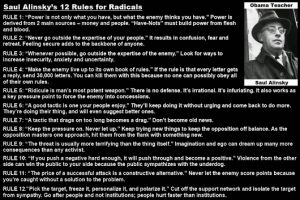What is the Role of a Community Organizer?
Saul Alinsky and Paolo Freire are both organizers and educators, who view their role in the process of organizing and activism differently.
Alinsky believes in confrontation and the creation of a problem within a community in order for change to occur. There are three quotes that define his ideological beliefs:
- “Only in the frictionless vacuum of a nonexistent abstract world can movement or change occur without that abrasive friction of conflict” (Alinsky, 1971, p. 21).
- “Thermopolitically they (Have-nots) are a mass of cold ashes of resignation and fatalism, but inside there are glowing embers of hope which can be fanned by the building of means of obtaining power” (Alinsky, 1971, p. 19).
- “Organizers are not only essential to start and build an organization; they are also essential to keep it going” (Alinsky, 1971, p.65).
The three quotes above emphasize Alinsky’s philosophy that there must always be a professional organizer involved in communities where injustices occur and activism is necessary for change. However, he also views this as a form of education, as mobilizing community members to the front-lines of organizing is a form of on-the-job training that is crucial to learning and understanding.

Source: https://plus.google.com/+WaltArmour/posts/bPFZDKTfvoR
Freire differs from Alinsky, in regards to the responsibility of the professional organizer. He has a stronger vision of combining education with activism, supporting the idea of human liberation and people learning from their own experiences. “He argued that in order to build a stronger democracy, education must be rooted in the lived experiences of the people who are learning and in the development of critical consciousness” (Martinson & Su, 2012, p. 65).
Here are some additional quotes that define his beliefs of liberation education:
- “A Freirian approach to liberation education involves a facilitated social action process in which groups come together in “culture circles” to listen to each other, engage in dialogue about the struggles in their live…” (Martinson & Su, 2012, p. 66).
- Therefore, “this methodology of listening-dialogue-action-reflection represents a participatory model of learning that promotes the development of conscientization, or critical consciousness that leads to action” (Martinson & Su, p. 66).
What Is the Point?
It is important to understand these key approaches to organizing because historically, they have been critical elements to movements and organizational strategies. Despite the differences however, the end goal for both models is change. It is important to have a balance of any ideology, such as Alinsky and Freire. Alinsky might believe more firmly in the agitator, or professional organizer, while Freire believes in the interaction and dialogue between individuals sharing their experiences. Both models have been successful and failed and different points, but understanding the approaches is key to understanding organizing. A combination of the two approaches can help communities “gain influence in the policymaking process while also facilitating transformative experiences though which people gain a greater sense of control over their lives through a social action process focused on critical consciousness and praxis” (Martinson & Su, p. 76).
